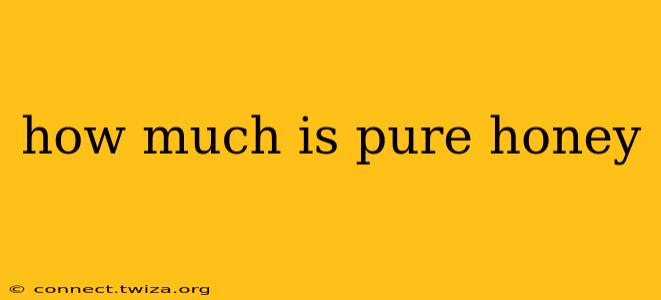How Much is Pure Honey? A Deep Dive into Pricing and Factors Affecting Cost
The price of pure honey varies significantly, and there's no single answer to "how much is pure honey?" The cost depends on several interconnected factors, making it crucial to understand what influences the final price you'll pay at the store or farmers market. Let's break down the key elements determining the cost of this golden nectar.
What factors influence the price of pure honey?
1. Type of Honey: Different floral sources yield honey with varying flavors, colors, and even textures. Honey from rare or highly sought-after flowers, like Manuka honey from New Zealand, commands significantly higher prices than more common varieties like clover or wildflower honey. The unique properties and purported health benefits associated with certain types of honey directly impact their cost.
2. Production Methods: The methods used in honey production influence price. Honey harvested sustainably and ethically, often from smaller, family-run operations, will typically cost more than commercially produced honey. Organic certification adds to the expense, reflecting the higher costs of sustainable farming practices.
3. Location and Availability: Geographic location plays a vital role. Honey from remote regions or areas with limited production might be more expensive due to transportation costs and lower overall supply. Seasonal availability also matters; honey produced during a short harvest period might be priced higher due to limited quantity.
4. Processing and Packaging: Raw honey, minimally processed, usually costs less than honey that's undergone extensive filtration, heating, or other processing methods. The type of packaging—glass jars versus plastic containers—also impacts the final price. Premium packaging often adds to the overall cost.
5. Retailer and Marketplace: The place you purchase honey affects the price. Buying directly from a local beekeeper is usually cheaper than purchasing from a supermarket, which includes additional retail markups. Online marketplaces can offer a broader selection, but shipping costs need to be considered.
How much can I expect to pay for different types of honey?
It’s difficult to give exact prices because of the variables mentioned above. However, a general range can give you an idea:
- Common varieties (e.g., clover, wildflower): You might find these ranging from $8 to $15 per pound, depending on location and retailer.
- Specialty honeys (e.g., Manuka, buckwheat): These can range from $20 to well over $100 per pound, with prices often increasing with the potency of the unique properties (e.g., UMF rating for Manuka honey).
- Raw honey: Often slightly cheaper than its processed counterpart, but it still depends on other influencing factors.
Where can I find affordable yet pure honey?
- Local Farmers' Markets: Connect directly with beekeepers and often find better prices and a higher quality product.
- Local Beekeepers: Many beekeepers sell their honey directly, often offering a range of varieties and price points. Look for online listings or local agricultural directories.
- Co-ops and Specialty Stores: These stores often prioritize local and sustainably produced food, offering a range of honey options.
Remember, pure honey should always be labeled as such, and you should be wary of overly low prices, as this might indicate lower quality or less ethical practices. By understanding these factors, you can make informed decisions and find the best pure honey to suit your needs and budget.
